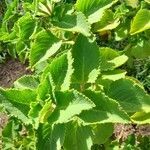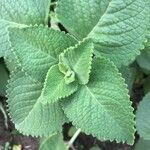Perennial, succulent, many-stemmed herb; stems decumbent, up to 1.5 m long, pubescent, with ascending inflorescences. Leaves petiolate; blade fleshy, drying thick-textured, broadly ovate to ovate-deltoid, 25-45 x 25-40 mm, densely pubescent, both surfaces with pale to brownish gland-dots, apex obtuse to rounded, base truncate to abruptly attenuate, margin finely crenate; petiole 4-10 mm long. Inflorescence slender, spike-like, 100-300 mm long; flowers in densely glomerate verticils spaced 10-30 mm apart; bracts persistent to flowering stage. Calyx 5-6 mm long in fruit, glandular-villous; uppermost tooth much larger than the rest, oblong to broadly oblong, abruptly apiculate. Corolla lilac, mauve or whitish, 7-9 mm long; tube slightly bent about the middle and expanding to the throat; upper lip 1.5-2 mm long, lower lip boat-shaped, 4 mm long. Stamens united at the base for 1-2 mm, 4-5 mm long.
A small hairy rather succulent herb. It keeps growing from year to year. It is erect. It grows up to about 50 cm high. The base of the stem becomes woody when old. The fleshy leaves are in opposite pairs. They are egg shaped with teeth around the edge. The leaves are yellowish green and hairy. The flowers are around a central stalk and are small and pale purple. The leaves have a sweet smell. Possibly now Coleus amboinicus.





